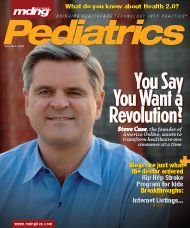Publication
Article
MDNG Pediatrics
You Say You Want a Revolution?
Steve Case is on a mission to save healthcare, and he intends to do it by harnessing the consumer-empowering capabilities of the Internet.
His advantage? He’s a personally motivated billionaire with plenty of Internet experience—you may recognize his name from the America Online (AOL) days, when he piloted the fledgling Internet company he co-founded with two other entrepreneurs into one of the greatest success stories in American business history, only to see it fade away following a merger with Time Warner that Case has referred to as a “failure in timing and execution.”
Although the 2001 merger was the beginning of the end for AOL—and the beginning of millions of dollars in losses for Case and other shareholders—at the time, Case was worrying about a much more important issue; 2001 was also the year his brother, Dan, was diagnosed with a brain tumor. Sadly, Dan passed away in June of 2002. Case attributes part of his motivation for starting Revolution Health to his family’s exhausting and frustrating experiences with the healthcare industry as a result of his brother’s illness. Visitors to Case’s blog on RevolutionHealth.com will find a post titled “Why I Started Revolution Health,” that explains this personal motivation. He writes about his brother, who “was fighting for his life, but had to divert much of his already-sapped energy to deal with bureaucracies, fi lling out forms, waiting in lines, trying to keep track of his medications, all the while seeking out other patients, and exchanging perspectives on treatment options.” Case also says that, “even though the United States has many of the world’s best doctors, hospitals, and technologies, the ‘system’ continues to make things diffi cult, cumbersome, and frustrating.” This is why he founded Revolution Health, to catalyze a much-needed revolution, “led by the people, for the people.”
The Revolution Health Network, which comprises RevolutionHealth.com, several other companies and online properties acquired over the past couple of years (Case has poured more than $100 million into the Network), and an array of partnerships, was named the number one health property on the Internet in February, according to comScore rankings. Case explains that RevolutionHealth.com was able to achieve this ranking because it successfully implemented a multi-brand strategy that included the acquisitions of HealthTalk—which provides information to patients suffering from chronic illnesses—and CarePages, a MySpace.com-type website designed to “connect family and friends during illness and injury.” Revolution Health
has also partnered with SparkPeople—a leading diet and fi tness website—and DrugStore.com, where visitors can purchase a variety of products they would fi nd in their local pharmacy or vitamins and supplements store. Case maintains that RevolutionHealth.com is and will remain the cornerstone of his strategy, but he has always believed that “the healthcare industry is a multi-faceted marketplace and that there isn’t a one-size-fits-all solution.” He says that RevolutionHealth.com will continue to pursue strategic alliances with affi liates that focus on specific niches within healthcare in order to provide a well-rounded consumer experience.
A difficult beginning
Case has worked from the start to ensure that RevolutionHealth.com is anchored with trusted content from reliable sources such as the Mayo Clinic, the Cleveland Clinic, and Harvard Medical School, and that it provides a user-friendly, interactive experience for members who want to discuss their health and share resources. You might then expect that the site would be crowded with visitors eager to chat about the information they’ve read on the site, share opinions, offer support, and seek advice. However, one thing that stands out when you visit RevolutionHealth.com is the scarcity of comments and user input on the blog postings, forums, doctor and hospital ratings, and every other resource that depends on extensive consumer interaction to be successful.
Case is the first to admit that uptake has been slow, but he explains that it has only been a year since RevolutionHealth.com launched and that the most important step was to get the site up and running. Now, he is shifting focus and working to build a level of comfort and trust with consumers, something that he says will take time. He likens the experience to his early AOL days. “We’ve always viewed this as a process,” he says. “I think it will take a number of years before we really have the kind of traction that we think we’ll ultimately have. What we’ve been able to accomplish over the past year is impressive, and we acknowledge that there’s still a lot of work to be done. The first year after we launched our first service in the ‘80s, I think we had less than 50,000 customers, and they were using it something like only an hour a week. Now, tens of millions of customers are using it multiple hours each day. These things take time.”
A major obstacle to Revolution’s social networking approach is that healthcare presents unique challenges to efforts to promote consumer interaction and empowerment. For example, until very recently, much of the information that would be most useful in making an informed healthcare decision (price, outcomes and other quality measures, etc) was simply not available. Another challenge stems from the mindset of patients used to a healthcare system that often removes choices from them and masks in a variety of ways the true cost of care. Scott Shreeve, MD, author of the healthcare IT blog Crossover Health, thinks this is an especially critical challenge, and questions whether consumers can really be encouraged to take personal and fi nancial responsibility of their health when they don’t think twice about spending $2,000 on a home entertainment system, but balk at paying $75 to see a trained healthcare professional.
Case agrees that it will be difficult to get people to change their habits and expectations when it comes to healthcare. “There’s no question that over the last half a century, we’ve trained consumers to really abdicate health decisions,” he says. “The basic thought process for the consumer was ‘if I partially pay, or if the government is paying, then I guess it’s not unreasonable if they have a strong say in how this plays out.’” Ever the optimist, however, Case believes that he can help change this and is encouraged because “consumers actually do have a fair say and are demonstrating the ability to recognize and pay for value in the whole business of staying healthy and feeling good and looking good. It’s only when you get sick that you move into what we call the ‘healthcare system.’ But the industry of staying healthy—whether it be the fi tness club, or the vitamin supplements, or massage—is already predominantly a ‘consumer chooses, consumer pays’ retail marketplace. It’s only the business of sickness that is the complex institution we characterize as ‘healthcare.’ We now need to turn our attention to the ‘dealing with sickness’ industry, which has many of the challenges and problems we have been talking about.” Whether Case’s estimation of consumers being more involved with “staying healthy” than the “business of sickness” is accurate may be irrelevant. The real question is whether he will be able to catalyze a “revolution” with the Revolution Health Network and social networking strategy. It’s like the old saying: “you can lead a horse to water, but you can’t make it drink.” Consumers may understand the benefi ts of taking a more active role in their health, but in the end it is up to them to make that effort. So far on RevolutionHealth.com, there’s been minimal consumer engagement.
Hype, or merely growing pains?
John Moore, a managing partner at the healthcare industry analyst firm Chilmark Research and an experienced IT analyst in the healthcare sector, believes that, right now, Revolution Health isn’t much more than a lot of hype. He openly agrees with Steve Case that healthcare is in need of a “revolution” that will be driven in large part by the consumer. However, Moore also believes that Revolution Health is “a company looking for a problem to solve,” and that “it hasn’t quite fi gured out where it fits.” He thinks that Case and company do not fully understand what needs to be done to catalyze a consumer-driven revolution in healthcare, and refers to their methods as a “strategy du jour.”
Right now, according to Moore, “They are at the roulette table placing bets on black, red, odds and evens, and then they are waiting to see where the marble is going to drop. They have the RediClinic brand; they have the CarePages; they have the basic health content; they have a personal health record on their site. They have all these different things, but I haven’t seen a very good synergy across the diff erent products they have. They haven’t really thought through how they should knit those things together.” A couple months ago, Moore posted an entry on his Chilmark Research website titled “Odd, Facts Don’t Support Revolution Health’s Claim.” In it, he draws some attention to the confusing numbers used to promote Revolution Health as the number one health property on the Internet. When Case purchased the online properties HealthTalk and SparkPeople in late 2007, the Revolution Health Network was catapulted up the rankings in terms of page views. Th ese strategic acquisitions by Case garnered some positive press for the “Revolu-tion Health” brand. However, the acquisitions were even more eff ective in diverting attention away from the tiny role RevolutionHealth.com’s traffic played in these rankings.
Moore posted an Alexa chart showing the traffic rankings of RevolutionHealth.com and WebMD.com from September 2007 to the time of his posting (February 2008). The graph clearly shows WebMD with a commanding lead in traffic, with little or no gain by RevolutionHealth.com. If Revolution Health (not RevolutionHealth.com) is the number one health property on the Internet, it’s not through traffic organically built by the site. WebMD has been able to foster significant consumer interaction on its site, perhaps in part because of the robust results returned by any healthcare-related search on WebMD. Searching for the same information on RevolutionHealth.com often does not yield similar results, something Moore is quick to point out. “I just don’t think Revolution has done a very good job of articulating their value proposition for the end user,” he says. “I go there and I use some common search terms to look for content, and usually I can fi nd better content just doing a Google search.”
There is no there there…yet
The surprisingly shallow pool of information, and other site deficiencies, can make it seem as though Revolution Health jumped into the market before it was fully prepared. Many of the site’s resources and features, like the “Find a Doctor” and “Compare Health Insurance” sections, are clunky and can be confusing to navigate. The website would be more useful if it had fewer, more intuitive features instead of trying to do too much at once and throwing resources up there just for the sake of having them. Has Revolution Health squandered a valuable opportunity to capture the public’s attention? Moore doesn’t think so, explaining that there’s still plenty of time and that, with some adjustments, the company should be able to get on track. He believes that at this point the only thing Revolution Health has really done is waste some money. Establishing a viable presence will take time, he says, because “going direct-to-consumer is a diffi cult nut to crack. At this stage of maturity in the market, the Revolution Health Network would be wise to develop some strong partnerships on the provider side.”
Case agrees that it is important for Revolution to establish relationships with physician groups in order to get a greater physician presence on the site. He says that, “We are absolutely interested; we’re having discussions with lots of different people and lots of diff erent organizations.” Case stresses that only time will tell, but that although his focus so far has been to get consumers more engaged in their healthcare, he also believes that physicians are just as frustrated as patients with the healthcare system, if not more so. He thinks that if he successfully convinces patients to be more active in their healthcare, they will put pressure on the system and allow physicians more time to “focus on the health issues and spend less time focusing on the bureaucratic issues.”
There is no questioning Case’s sincerity; his personal experiences have motivated him to push for major changes in American healthcare, and he deserves some credit for recognizing that he can (literally) afford to try and shake up the system. Streamlining the many features on the website into a more cohesive portfolio of resources might enable Case to gain the trust of the consumer. Revolution’s wisdomof-the-crowds approach would also be enhanced by adding an important element—physicians—who have had plenty of their own frustrating experiences with the healthcare industry. If there is going to be a revolution, it’s going to require the eff orts of stakeholders at every level of the healthcare system. And although RevolutionHealth.com has not been able to capture the attention of the public yet, Case is in it for the long haul. “RevolutionHealth.com has come a long way in a relatively short, 12-month period, but we’ll be at this for 10, 15, 20 years,” Case says. “I think of this as the top of the first inning and there’s still many more innings to play.”






